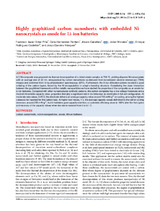Highly graphitized carbon nanosheets with embedded Ni nanocrystals as anode for Li-ion batteries
Autor
Soler-Piña, Francisco Javier
Hernández-Rentero, C.
Caballero Amores, Álvaro
Morales Palomino, Julián
Rodríguez-Castellón, Enrique
Canales-Vázquez, Jesús
Fecha
2020Materia
Carbon nanosheetsNickel nanoparticles
Anode
Lithium batteries
METS:
Mostrar el registro METSPREMIS:
Mostrar el registro PREMISMetadatos
Mostrar el registro completo del ítemResumen
A C/Ni composite was prepared via thermal decomposition of a nickel oleate complex at 700 °C, yielding disperse Ni nanocrystals with an average size of 20 nm, encapsulated by carbon nanosheets as deduced from transmission electron microscopy (TEM) images and confirmed from X-ray photoelectron spectroscopy (XPS). Furthermore, the X-ray diffraction pattern revealed a good ordering of the carbon layers, forced by the Ni encapsulation to adopt a bending structure. Considering the close interaction between the graphitized framework and the metallic nanoparticles we have studied the properties of the composite as an anode for Li-ion batteries. Compared with other nanostructured synthetic carbons, this carbon composite has a low voltage hysteresis and a modest irreversible capacity value, properties that play a significant role in its behaviour as electrodes in full cell configuration. At moderate rate values, 0.25 C, the electrode delivers an average capacity value around 723 mAh·g−1 on cycling, among the highest values so far reported for this carbon type. At higher rate values, 1 C, the average capacity values delivered by the cell on cycling decrease, around 205 mAh·g−1, but it maintains good capacity retention, a coulombic efficiency close to 100% after the first cycles and recovery of the capacity values when the rate is restored from 3 to 0.1 C.

